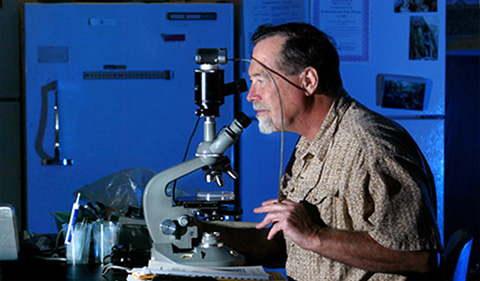By MC Tilton, PACE Writer
A new cellular slime mold family and genus have been named after Dr. James Cavender, Professor Emeritus of Environment & Plant Biology, whose decades of work have distinguished him as the leading expert on Dictyostelids.
When Cavender began working on his Ph.D. in the early 1960s, only about 30 species of cellular slime molds had been discovered. His major professor, Ken Raper at the University of Wisconsin, stimulated Cavender’s interest in the soil-improving organisms, and from there, he says, the rest is history.
“I’ve been working for over 50 years on the same thing, and after 50 years you build up kind of a reputation. It’s hard to believe it all worked out,” Cavender said.
Cellular slime molds feed on bacteria like E. Coli in soil, and without their control, the health animals and plants would deteriorate. Over a life span of just three days, they divide and conquer to aid in decomposition and regulate soil health, making them “earth’s smallest farmers.”
Cavender has traveled across the globe by himself and with various teams over the years to find new slime molds, hitting South Africa, Patagonia, Thailand, Belize, and many more locations in his adventures. His expeditions yielded the discovery of more than half of the 150 known varieties of slime molds. These discoveries were instrumental in the study of evolution in these organisms. Cavender’s achievements are now reflected in the recent naming of a new family, Cavenderiaceae, and new genus, Cavenderia.
Although Cavender retired in 2004, he still comes into his lab at Ohio University several times a week because he loves the research way of life. He is humbled to see a lifetime of work culminated in the genus and family naming.
“It means a lot to me, you know, most of the time nobody really knows what you do,” Cavender said. “You never know if your work is going to amount to anything, and fortunately for me, it did.”
The paper in Protist describing the new family and genus is titled “A New Classification of the Dictyostelids,” co-authored by Sheikh, S., Thulin, M., Cavender, J.C., Escalante, R., Kawakami, S., Lado, C., Landolt, J.C., Nanjundiah, V., Queller, D.C., Strassmann, J.E., Spiegel, F.W., Stephenson, S.L. Vadell, E.M. & Baldauf, S.L. 2017. A new classification of the Dictyostelids.
Abstract: Traditional morphology-based taxonomy of dictyostelids is rejected by molecular phylogeny. A new classification is presented based on monophyletic entities with consistent and strong molecular phylogenetic support and that are, as far as possible, morphologically recognizable. All newly named clades are diagnosed with small subunit ribosomal RNA (18S rRNA) sequence signatures plus morphological synapomorphies where possible. The two major molecular clades are given the rank of order, as Acytosteliales ord. nov. and Dictyosteliales. The two major clades within each of these orders are recognized and given the rank of family as, respectively, Acytosteliaceae and Cavenderiaceae fam. nov. in Acytosteliales, and Dictyosteliaceae and Raperosteliaceae fam. nov. in Dictyosteliales. Twelve genera are recognized: Cavenderia gen. nov. in Cavenderiaceae, Acytostelium, Rostrostelium gen. nov. and Heterostelium gen. nov. in Acytosteliaceae, Tieghemostelium gen. nov., Hagiwaraea gen. nov., Raperostelium gen. nov. and Speleostelium gen. nov. in Raperosteliaceae, and Dictyostelium and Polysphondylium in Dictyosteliaceae. The “polycephalum” complex is treated as Coremiostelium gen. nov. (not assigned to family) and the “polycarpum” complex as Synstelium gen. nov. (not assigned to order and family). Coenonia, which may not be a dictyostelid, is treated as a genus incertae sedis. Eighty-eight new combinations are made at species and variety level, and Dictyostelium ammophilum is validated.




















Comments